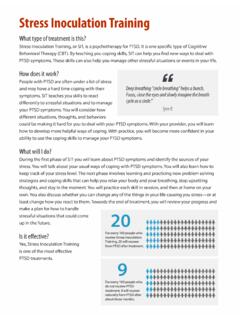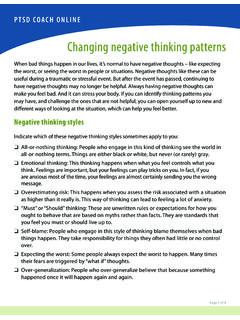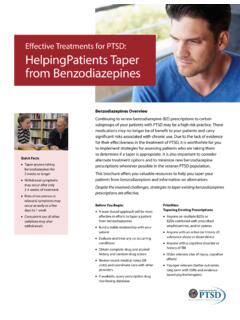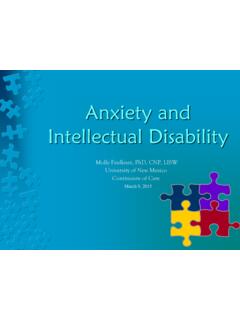Transcription of A Guide to Guidelines for the Treatment of Posttraumatic ...
1 A Guide to Guidelines for the Treatment of Posttraumatic Stress Disorderin Adults: An UpdateJessica L. HamblenNational Center for ptsd , White River Junction, Vermont, andGeisel School of Medicine at DartmouthSonya B. NormanNational Center for ptsd , White River Junction, Vermont, andUniversity of California San Diego School of MedicineJeffrey H. SonisUniversity of North Carolina at Chapel Hill School of MedicineAndrea J. PhelpsUniversity of MelbourneJonathan I. BissonCardiff UniversityVanessa D. NunesRoyal College of Obstetricians and GynaecologistsOdette Megnin-ViggarsRoyal College of Obstetricians and Gynaecologists andUniversity College LondonDavid ForbesUniversity of MelbourneDavid S.
2 RiggsUniformed Services University of the Health Sciences andCenter for Deployment Psychology, Bethesda, MarylandPaula P. SchnurrNational Center for ptsd , White River Junction, Vermont, andGeisel School of Medicine at DartmouthClinical practice Guidelines (CPGs) are used to support clinicians and patients in diagnostic and treatmentdecision-making. Along with patients preferences and values, and clinicians experience and judgment,practice Guidelines are a critical component to ensure patients are getting the best care based on the mostupdated research findings. Most CPGs are based on systematic reviews of the Treatment most reviews are now restricted to randomized controlled trials, others may consider nonran-domized effectiveness trials.
3 Despite a reliance on similar procedures and data, methodological decisionsand the interpretation of the evidence by the guideline development panel can result in differentrecommendations. In this article, we will describe key methodological points for 5 recently releasedCPGs on the Treatment of Posttraumatic stress disorder in adults and highlight some of the differences inboth the process and the subsequent L. Hamblen, National Center for ptsd , White River Junction,Vermont, and Department of Psychiatry, Geisel School of Medicine atDartmouth; Sonya B. Norman, National Center for ptsd , and Departmentof Psychiatry, University of California San Diego School of Medicine;Jeffrey H.
4 Sonis, Department of Social Medicine and Department ofFamily Medicine, University of North Carolina at Chapel Hill School ofMedicine; Andrea J. Phelps, Phoenix Australia, Centre for PosttraumaticMental Health, Department of Psychiatry, University of Melbourne; Jon-athan I. Bisson, Cardiff University School of Medicine, Cardiff University;Vanessa D. Nunes, National Guideline Alliance, Royal College of Obste-tricians and Gynaecologists; Odette Megnin-Viggars, National GuidelineAlliance, Royal College of Obstetricians and Gynaecologists, and ResearchDepartment of Clinical, Educational & Health Psychology, UniversityCollege London; David Forbes, Phoenix Australia, Centre for Posttrau-matic Mental Health, Department of Psychiatry, University of Melbourne;David S.
5 Riggs, Department of Medical and Clinical Psychology, Uni-formed Services University of the Health Sciences and Center for Deploy-ment Psychology, Bethesda, Maryland; Paula P. Schnurr, National Centerfor ptsd , and Department of Psychiatry, Geisel School of Medicine thank Juliette Harik, National Center for ptsd , for her comments onmultiple drafts. The NICE guideline referred to in this article was producedby the National Guideline Alliance for the National Institute for Health andCare Excellence. The APA guideline was developed by the AmericanPsychological Association (APA) ptsd Treatment Guideline Develop-ment Panel and adopted as APA Policy by the Council of Representativeson February 24, 2017.
6 The Australian Guidelines were produced by Phoe-nix Australia Centre for Posttraumatic Mental Health. The views expressedin this article are those of the authors and not necessarily those of the APA,Department of Veterans Affairs, Department of Defense, InternationalSociety for Traumatic Stress Studies, Phoenix Australia Centre for Post-traumatic Mental Health, or concerning this article should be addressed to Jes-sica L. Hamblen, National Center for ptsd (116D), VA MedicalCenter, 215 North Main Street, White River Junction, VT the public domain2019, Vol. 56, No. 3, 359 373 Impact StatementQuestion:What are the primary Posttraumatic stress disorder Treatment recommendations across thevarious Posttraumatic stress disorder clinical practice Guidelines ?
7 Findings:All of the guidelinesgave the highest overall recommendations to trauma-focused psychotherapies (usually including eyemovement desensitization and reprocessing), and all agreed that selective serotonin reuptake inhib-itors (either specific ones or the whole class) were the most effective :Thereis general consistency across the Posttraumatic stress disorder clinical practice :Clinical practice guideline recommendations need to be disseminated to clinicians and, alongwith patient preferences, used to Guide Treatment : Posttraumatic stress disorder, evidence-based Treatment , clinical practice guidelineChoice is an integral component in the process of treatingphysical and mental health conditions first, about whether anytreatment will be pursued and, second, the nature of the treat-ment(s) that will be used.
8 In the optimal scenario, the decision isinformed by scientific evidence, a clinician s experience and train-ing, and a patient s preferences and values. These three elementsmeet the definition of an evidence-based practice provided by thePresidential Task Force on Evidence-Based Practice (APA Presi-dential Task Force on Evidence-Based Practice, 2006).Clinical practice Guidelines (CPGs) are intended to facilitatechoice. The National Academy of Medicine (formerly called theInstitute of Medicine [IOM], 2011) defines CPGs as statementsthat include recommendations intended to optimize patient carethat are informed by a systematic review of evidence and anassessment of the benefits and harms of alternative care options (p.)
9 4). Although they make recommendations for how a givenproblem should be treated, Guidelines are not mandates:Rather than dictating a one-size-fits-all approach to patient care, CPGsare able to enhance clinician and patient decision-making by clearlydescribing and appraising the scientific evidence and reasoning (thelikely benefits and harms) behind clinical recommendations, makingthem relevant to the individual patient encounter. (p. 1) Guidelines support, but do not dictate, the initial formalization of the diagnostic criteria forposttraumatic stress disorder ( ptsd ) in theDiagnostic and Sta-tistical Manual of Mental Disorders(3rded.;DSM III;AmericanPsychiatric Association, 1980), Guidelines for treating ptsd havebeen developed and revised as the evidence on Treatment hasevolved.
10 In 2011, a seminal report by theIOM (2011)significantlychanged the criteria for developing trustworthy Guidelines . Ac-cording to the report, Guidelines should (a) be based on a system-atic review of evidence, (b) be developed by experts from multipledisciplines and include stakeholder input, (c) take patient sub-groups and preferences into consideration, (d) be based on atransparent process that reduces bias and conflict of interest, (e)provide ratings of the quality of evidence and strength of out-comes, and (f) be revised to maintain currency as new evidenceemerges. One of the most significant implications of these recom-mendations is the emphasis on evidence, rather than clinical con-sensus, as a basis for making 2010, Forbes and colleagues (Forbes et al.)














